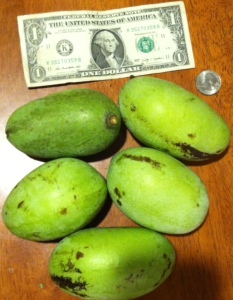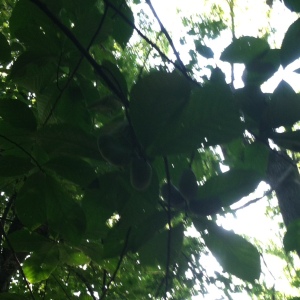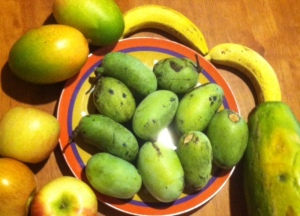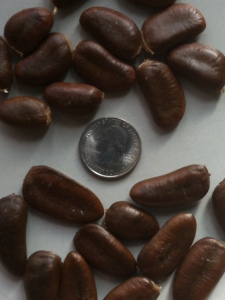Well, hardly anyone. The fruit apparently doesn’t keep very long, making it difficult to ship it, stock it on shelves and sell it. And if no one can make money selling it, no one will.
I took the photo above for perspective on the size of paw paws, placing five of my largest ones by a quarter and a dollar bill. I get a kick out of finding something edible of this size growing wild – and my kids had fun hiking and hunting for them after school with me. I find it odd that there are thousands of these trees growing just a short distance from where we live, yet my friends and my kids had never seen or heard of them before.
The name “paw paw” might have come about because the fruit looks somewhat like a small papaya. The trees themselves have root structures somewhat like mango trees, and they are of the genus Asimina, the only genus of the Anonaceae family of trees which is not tropical. Paw paws live throughout the southeastern third of the United States, and I have read of people finding them in 26 states as far west as Nebraska and as far north as New York.
I just found my first harvest in Pennsylvania, just a few hundred feet from the Susquehanna River in Lancaster County.
The fruit is the same green color as the leaves of the tree, but it is not as difficult to spot the fruit as the photo above might indicate. I found my first ones after less than a minute on the trail, and many dozens more afterwards. Enough to know I could leave the smaller ones behind and focus on larger fruit. I know of three good ways to get the paw paws from the tree: the best would be to use an extension pole with a looped hook and basket on the end. A pole ten to fifteen feet long, with a hook an inch wide, with a basket 6-12 inches wide would be perfect. I did not have one of those, so I used a fishing net on a long handle, which worked most of the time, but it offered no way to yank fruit off the branch if it wasn’t about to fall on its own. A second method is to just shake the trees when you see fruit. Paw paw trees are usually less than four inches wide, and shaking usually dropped a few fruit to the ground (though on a forested hillside in a river valley, many rolled away.) And the last method is good old tree-climbing to get high enough to reach the fruit, or at least to bend down the branch it’s on. Of course, a guy my size tends to bend the whole tree down once I’m even a few feet above the ground.
I had learned last year that mid to late September is prime time for getting wild paw paws (I have also heard them called “Susquehanna bananas” and “custard apples” due to the location of a large paw paw patch and the gooey, custard-like consistency of a ripe paw paw.
In the photo above, a plate of ten paw paws I picked off low hanging branches on September 16 is surrounded by some of the other fruits it is most often compared to: (clockwise from bottom left – apples, mangos, bananas, and a papaya.) The fruit is like a hard apple when not yet ripe, and the off-white flesh inside does not taste very good when unripe. The ripest ones are more mushy than an overripe banana, and that is when they taste good – though is may seem squishy and ruined to anyone not familiar with paw paws, this is when you want to eat them – when the contents inside are more like a yellow custard-like goo containing far too many giant black seeds. You can’t miss the seeds – they are at least an inch long and each fruit has about 10-15 seeds.
Of course if you do miss some of the seeds as you put your paw paw into a blender with some milk and ice cream is the hope of making a delicious smoothie… it won’t come out as delicious as planned. So do be careful. I have also read that the seeds are slightly toxic – or that they have cancer-fighting qualities and should be considered medicinal. In my limited understanding, the seeds contain compounds that hinder cell function in fast dividing cells – if you have cancer, they might focus on those cells. If you don’t they might zero in on your stomach lining and intestinal lining and cause nausea or vomiting. They are used by some to fight cancer, intestinal parasites, and other ailments. I’m not a doctor. I’d hate to see anyone ruin a good meal, let alone a pregnancy, by eating such seeds. I’d play it safe and skip the seeds, besides, they don’t taste very good.
The last photo above showing someone slicing through an opened paw paw (of medium ripeness – by my standards) is from this Wikipedia article.
So if you can find the trees in your neck of the woods, and you like banana smoothies, or mango, or papaya… and you would get a kick out of finding some of North America’s largest and least known native fruit – mid to late September is the time to go out and grab some fresh paw paws. Enjoy!





